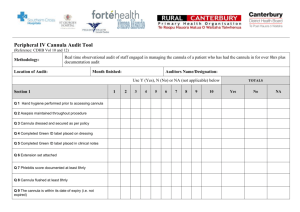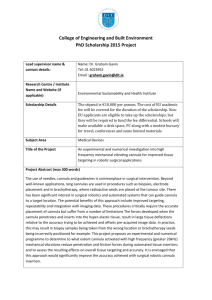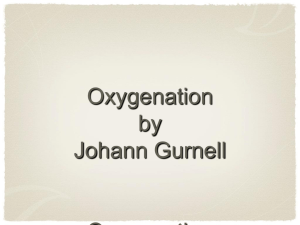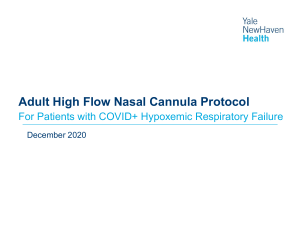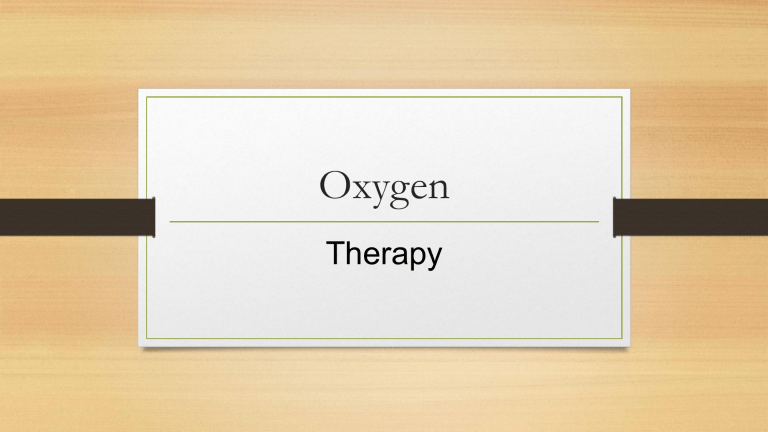
Oxygen Therapy Oxygen Therapy • Oxygen Therapy is the administration of oxygen to the client by any route to prevent or relieve hypoxia. The provision of oxygen to the client with higher concentration than that found in air. Rationale: Oxygen is essential to life. An optimum level of oxygen must be maintained to sustain mental functioning. Indication • Any condition which either actually or potentially lead to hypoxia or hypoxemia. Examples: chronic obstruction, respiratory depression,inflammation and cardiac insufficiency. Methods of Oxygen Delivery: a. Nasal Cannula/ Prongs- simple, comfortable, low flow (24%-45%) device inserted into the nostrils to deliver at a rate up to 5-6 liters/min. It consist of a rubber or plastic tubings that extends around the face with ¼ to ½ inch curved prongs that fit into the nostrils. Purposes: 1. To deliver a relatively low concentration of oxygen when only minimal support is required. • 2. To allow uninterrupted delivery of oxygen while the client ingest foods and fluids. • To permit some freedom and movement and comfort to client. FACE MASK • A device that covers the clients nose and mouth for oxygen inhalation. They are made of clear pliable plastic or rubber that can be molded to fit the face. Held to the clients head with elastic Preparation: Assemble Equipments and Supplies Cannula Face Mask Face Tent • Determine • The order for oxygen • Levels of oxygen • V/S • Diagnostic results ASSESSMENT • 1. Identified patient using two identifiers. • 2. Reviewed patient chart or heath record including health care provider's order and nurses notes. • 3. Reviewed patient order for oxygen, noting delivery method, flow rate, duration of oxygen therapy, and parameters for titration of oxygen settings. • 4 Assessed patients/ family caregiver's health literacy. • 5.Perform hand hygiene and apply clean gloves. • 6. Performed respiratory assessment. • 7. Observed for cognitive and behavioral changes. • 8. Assessed airway patency and remove airway secretions by having patient cough and expectorate mucus or by suctioning. Auscultated lung sounds. Removed and disposed of gloves and performed hand hygiene if there was contact with mucus. Then reapplied gloves if further contact with mucus was likely. • 9. Inspected condition of skin around nose and ears. • 10. Removed and discarded gloves if worn; performed hand hygiene. • 11. Assessed knowledge and experience of patient and family caregiver with oxygen administration. • 12. Assessed patient's goals or preferences for how oxygen administration should be performed. • PLANNING • 1. Determined expected outcomes following completion of procedure. • 2. Gathered equipment/supplies at patient's bedside. • 3. Closed room door or curtains around bed. • 4. Instructed patient and/or family caregiver about need for oxygen. If the oxygen was for home use, educated patient about oxygen safety in the home and the equipment that would be used IMPLEMENTATION • IMPLEMENTATION • 1. Performed hand hygiene. Applied PPE. • 2. Adjusted bed to appropriate height and lowered side rail on side nearest you. Positioned patient comfortably in semi-Fowler position. • 3. Attached oxygen-delivery device to oxygen tubing and attached end of tubing to humidified oxygen source (if needed) adjusted to prescribed flow rate: a. Placed tips of the nasal cannula into patient's nares. If tips were curved, they should have pointed downward inside nostrils. Then looped cannula tubing up and over patient's ears. Adjusted lanyard so cannula fit snugly but not too tightly without pressure to patient nares and ears. b. Applied any type of oxygen mask by placing it over patient's mouth and nose. Then brought straps over patient's head and adjusted to form a comfortable but tight seal. • 5. Maintained sufficient slack on oxygen tubing. • 6. Observed for proper function of oxygendelivery de-vice: • a. Nasal cannula: Cannula was positioned properly in nares; oxygen flowed through tips. • b. Oxygen-conserving cannula: Fitted as for nasal cannula. Reservoir was located under patient's nose or worn as a pendant. • c. Nonrebreather mask: Applied as regular mask. • Contained one-way valves with reservoir; exhaled air did not enter reservoir bag. • d. Simple face mask: Selected appropriate flow rate. • e. Venturi mask: Selected appropriate flow rate. • f. High-flow nasal cannula: Fitted as for nasal cannula. • 7. Verified setting on flowmeter and oxygen source for proper setup and prescribed flow rate. • 8. Checked cannula/mask and humidity device if used) every 8 hours or as agency policy indicated. • Ensured that humidity container was filled at all times. • 9. Posted "Oxygen in use" signs on wall behind bed and at entrance to room (per agency policy). • 10. Helped patient to comfortable position. Raised side rails (as appropriate) and lowered bed to lowest position. • 11. Place nurse call system in an accessible location within patients reach. • 12. Properly disposed of gloves and other PPE, of used, and performed hand hygiene. EVALUATION • EVALUATION • 1. Monitor patients response changes in oxygen flowrate with SpO. Note: Monitored ABCs when ordered. • 2. Performed respiratory assessment. Obtained vital signs • 3. Assessed adequacy of oxygen flow each shift or per agency policy. • 4. Observed pase mucous memoran, bridge of nose, nares, and nasal mucous membranes for evidence of skin breakdown. • 5. Used Teach-Back. Revised instruction if patient or family caregiver was not able to teach back correctly. • RECORDING • 1. Recorded the respiratory assessment findings, method of oxygen delivery, oxygen flow rate, patient's response to intervention, and any adverse reactions or side effects; recorded status of patient's skin integrity on flow sheet in nurses' notes in EHR or chart. • 2. Documented evaluation of patient and family caregiver learning. • HAND-OFF REPORTING • 1. Reported patient status, including recent assessment findings, vital signs, SpO2, and skin integrity before and after oxygen administration. • 2. Reported the type of oxygen-delivery device initiated and used, the initial flow rates, and whether any adjustments to the flow rate were made during the Shift. Included the patient response to the flow rate adjustments and what interventions were successful. • 3. Reported any unexpected outcome to health care provider or nurse in charge.

